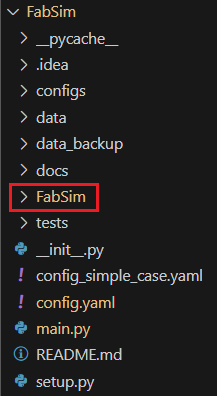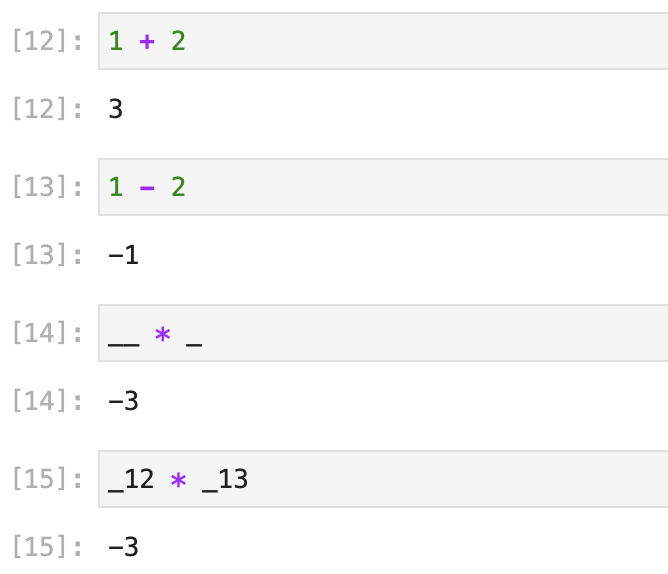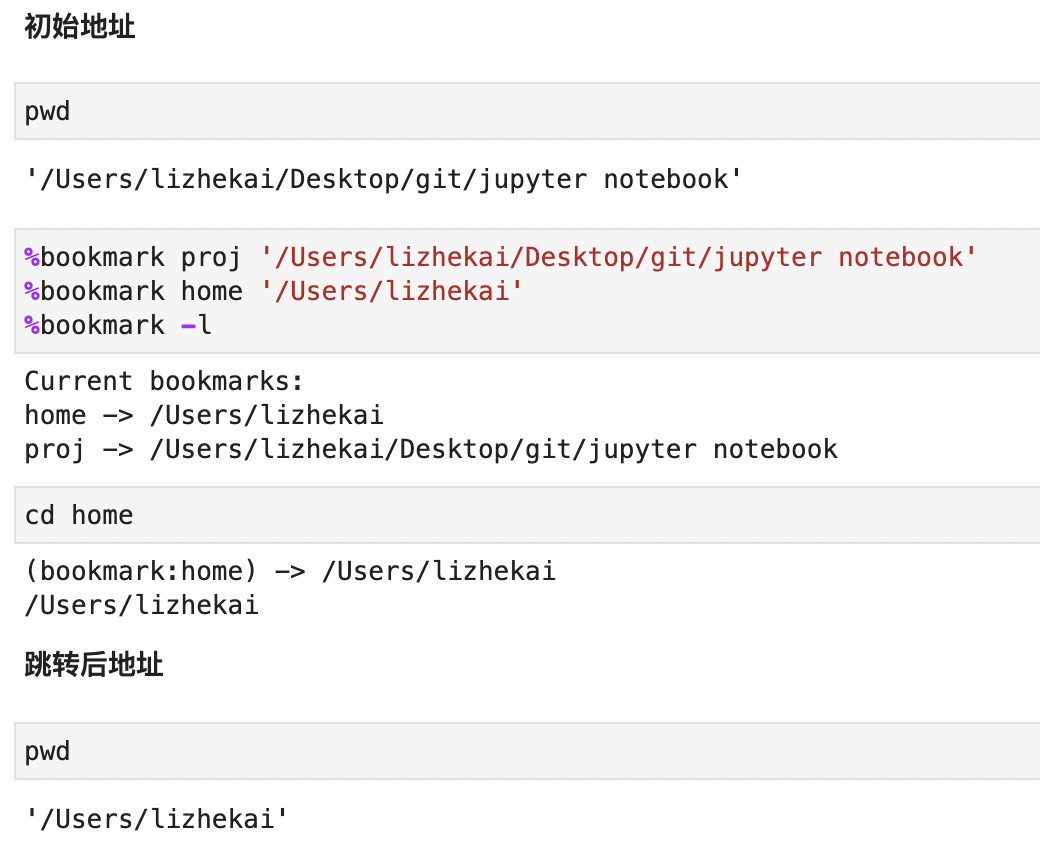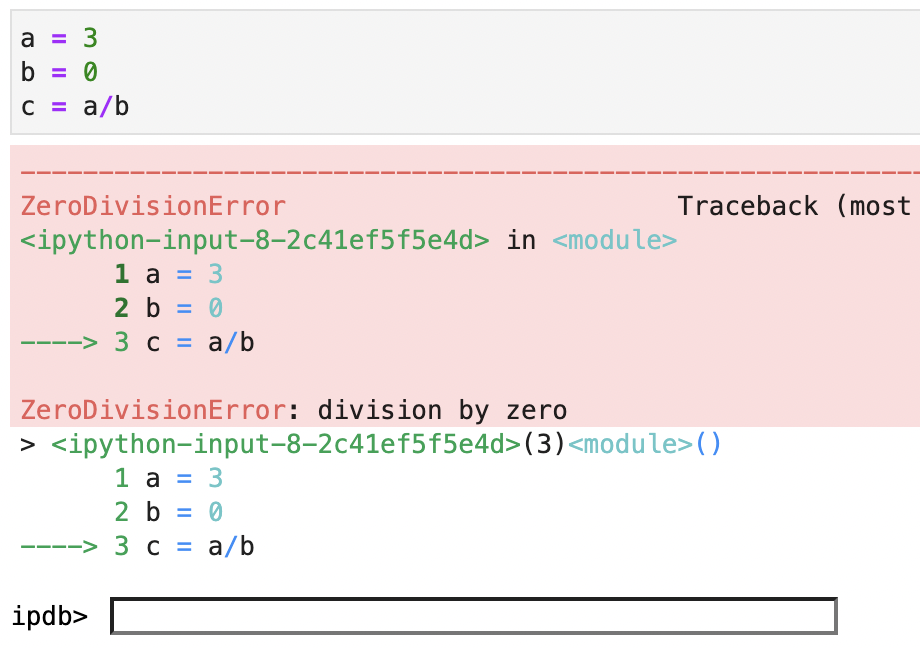Python Basis
(1) copy() & deepcopy()
非常非常需要谨记的点!会容易造成很臭的 bug (1.1) X.copy()/ copy.copy(X) 浅拷贝: 即只拷贝第一层,第二层及以下的嵌套对象还是指向同一个地址
(1.2) copy.deepcopy(X) 深拷贝: 拷贝所有层级,每一层都是新的对象
从而我们可以得到以下结论:
- 对于单层且仅包含数值的 list, 使用 copy() or deepcopy()
- 对于多层且仅包含数值的 list, 使用 deepcopy()
- 对于单层但包含引用对象的 list, 例如,如果不想让对
L1长度的修改影响到L和L2;但又想让对L1中obj1的修改能够同步到L和L2中的obj1,那么使用 copy()L = [obj1, obj2]; L1 = L.copy(); L2 = L.copy()
常见的应用场景如下:
- 经常使用于函数接收输入的过程:
import copy() class C1: def __init__(self, L=[], LL=[[]]): self.L = L.copy() self.LL = copy.deepcopy(LL) - 列表的赋值过程: 我们希望从一个字典中读出一个列表,并在对该列表进行修改后,放进另一个字典中去
L = D1['L'].copy() # 这里是 copy or deepcopy 取决于 L 的内容,具体参考开头部分的结论 L = change(L) D2['L'] = L
(2) eval 函数
eval 函数可以将字符串转换为 Python 代码并执行,例如:
eval('print("Hello World")')
当和 config.yaml 配合使用时,可以实现自定义执行任意函数,例如:
class_1:
func_1: true
func_2: false
c1 = Class_1()
for func in config['class_1']:
if config['class_1'][func] == True:
eval(f'c1.{func}()')
数据储存方式
(1) Reference in Stack Memory 栈(特点是后进先出,空间有限) 储存所有对象名。执行方式类似于执行嵌套函数:
- 首先外部函数进入栈,然后内部函数入栈
- 内部函数执行完后先出栈,然后外部函数出栈
(2) Objects in Heap Memory 堆(特点是无序杂乱,空间大) 储存所有创建的对象本身
1. Illustration
obj1 = MyObject()
id(obj1) >>> addr1
obj1对象名(实例的reference),储存在 stack memeory 中MyObject()实例(instance/ object),储存在 heap memory 中=等号相当于创建了一个指针地址 address,将对象名指向实例。该地址和对象名一起储存在 stack memory 中id(obj1)读取对象名所储存的地址

obj2 = obj1
obj1 is obj2 >>> True
id(obj1) == id(obj2) >>> True
- 把
obj1对应的地址(addr1)赋给了obj2,此时这两个对象名储存了同一个地址,因此指向同一实例对象

obj2 = MyObject()
- 又创建了一个新的实例对象,将其地址赋给
obj2 - 此时
obj1 is obj2 >>> False因为指向不同实例对象 - 但是
obj1 == obj2 >>> True因为他们指向的实例对象在属性值上相同
2. Examples
函数传参的本质是传递 object address。例如,下例中 F() 的执行过程相当于把 obj 对应的地址赋给 input
def F(input):
input.a += 1
obj = MyObject()
obj.a = 4
F(obj)
print(obj.a) >>> 5
再例如对于数组
def F(lis):
lis.append(1)
lis = [2,3]
L = [0]
F(L)
print(L) >>> [0,1]
因此不管是在函数内部修改 class 的 fields 还是修改 list (list.append) 等等,都能够传递到函数外部,因为本质上是在修改实例对象
但如果在函数内部进行的是赋值操作,那就不会传递到函数外部
文件操作
开关
f = open(<文件名>, <打开模式>) # 代码块 f.close()|打开模式| 描述| |-|-| |’t’| 文本文件模式,只读,默认值| |’b’| 二进制文件模式,只读| |’r’| 只读,若文件不存在会报错| |’w’| 覆盖写入| |’x’| 创建写入,若文件存在则报错| |’a’| 追加写入| |’+’| 与r/w/x/a一同使用,在原功能基础上增加同时读写功能| |’wb’| 二进制覆盖写| |’…’| …|
读写 ```py
读
f.read(size) # 读入全部(可选参数:读取前size长度) f.readline(size) # 读入一行(可选参数:读取前size长度) f.readlines(hint) # 读入全部行,返回一个列表(可选参数:读取前hint行)
写
f.write(s) # 写入一个字符串或字节流 f.writelines(lines) # 写入一个字符串列表 f.seek(offset) # 改变文件操作指针的位置(0: 文件开头,1: 当前位置,2: 文件结尾)
例如:
```py
f.writelines(["aa", "bb"])
f.seek(0) # 不写这一行代码,该程序将不会输出任何内容
for line in f:
print(line)
f.close()
>>>
"aabb"
函数
3.1 常用函数
enumerate(List)
L = [1,0]
for i, e in enumerate(L):
print(i, e)
>>>
0, 1
1, 0
eval() 执行并返回一个字符串表达式的值
a = eval("1 + 4")
b = eval("a * 6")
map(参数1, 参数2) 将参数1的方法作用于参数2得每一个元素
list(map(eval, ["1+1", "2*2"])) >>> [2, 4]
max(iterable, key=func) 使用 max + key 来发掘更多可用性
# 1. 统计列表中出现频率最高的元素
a = [1,2,3,1,2,3,2,2,4,5,1]
max(set(a), key=a.count) >>> 2
# 2. 求特定位置的最大值
lst = [(1,'a'), (3,'c'), (4,'e')]
max(lst, key=lambda x: x[0]) >>> (4, 'e')
3.2 lambda function
func = lambda [arg1, arg2, ...]: expression
Examples:
power = lambda a, b: a**b
power(2, 3) >>> 8
库
1. pip 命令
可以在 pypi.org 上根据关键字搜索第三方库
pip install <库名>
pip uninstall <库名>
pip install -U <库名> # 更新库
pip download <库名> # 下载但不安装
pip show <库名> # 查看库的详细信息
pip search <库名> # 检索与该库相关的信息
2. 构建自己的库
库名一般等于文件夹名,且文件夹中必须有一个 __init__.py 文件,该文件可以为空
2.1 库的结构

- FabSim 库名文件夹
__init__.pyFabSim主程序文件夹,一般同库名__init__.pycomponents组件程序文件夹untils工具程序文件夹- 以上仅为实例,实际情况可根据需要自行添加修改
datadocstestsconfig.yaml配置文件main.py主程序入口README.mdsetup.py安装文件
2.2 config.yaml 配置文件
参考: https://docs.ansible.com/ansible/latest/reference_appendices/YAMLSyntax.html
配置文件以字典的形式储存程序运行所需的参数,从而使得用户可以通过修改配置文件来改变程序的运行方式,而不需要修改程序本身。
如下示例展示了如何定义和使用 .yaml 文件:
- martin:
name: Martin D'vloper
company: &SKWS Skyworks Solutions, Inc. # 定义一个锚点
job: Developer
skills:
- python
- java
- tabitha:
name: Tabitha Bitumen
compnay: *SKWS # 使用锚点(简单理解为引用变量)
job: Developer
skills:
- SQL
- Excel
import ruamel.yaml
with open(config_dir, 'r') as f:
config = ruamel.yaml.safe_load(f)
print(config['martin']['name']) >>> "Martin D'vloper"
print(config['martin']['skills']) >>> ['python', 'java']
print(config['tabitha']['company']) >>> "Skyworks Solutions, Inc"
如果想要每次运行都保存一次配置文件,可以在程序中添加如下代码:
config['experiment_name'] = "new name"
with open("new_location.yaml", 'w') as f:
ruamel.yaml.dump(config, f, Dumper=ruamel.yaml.RoundTripDumper)
类
class CS:
def __init__(self, name):
self.name = name
# 定义 print(类对象) 时的输出值
def __str__(self):
print("Class: CS")
return "Name: " + self.name
cs = CS("Tom")
print(cs)
>>>
Class: CS
Name: Tom
ipython in Jupyter
ipython 是一个交互式 shell,同时被应用于 Jupyter。有很多方便的魔法命令:
1. 自动补全 Tab
2. 执行终端命令 ! + 终端命令 例如 !ifconfig
3. 模糊查找 查找内容 + ? 例如 list_1.*pp*? 能查找目标对象所有名字中带有 pp 字段的方法/属性
4. 查看信息 对象/方法 + ? 例如 list_1?, list_1.append?
5. 查看函数代码 函数名 + ?? 例如 help?? 查看help函数的使用方法
6. 运行python程序 %run + 文件名.py
7. 使用前面代码块的输出结果 _ 前面第一个, __ 前面第二个, _n 序号为n的代码块: 
1. 为地址设置书签
设置书签 %bookmark 书签名 地址 删除书签 %bookmark -d 书签名 删除所有书签 %bookmark -r 显示所有书签 %bookmark -l 跳转地址 cd 书签名

2. 代码调试
- 打开代码调试:
%pdb on - 之后如果运行错误代码,则会跳转到报错的前一行,并打开调试器,进入 pdb 调试模式,例如:

- 在调试器内输入调试命令,例如
p 变量名 # 查看变量值 - 退出调试:
q(uit)
Time Complexity
6.1 Big O
$O$ usually used as Time Complexity notation. Understood as how run time or space requirements grow as the input size grows
Big O mathematically defined as the upper bound. 对于函数 $f(x)$,如果存在 $c\in\R$,使得 $f(x)<c\times g(x)$ 在其定义域内恒成立,则有 $f(x)\in O(g(x))$
例如,$N^3+8N+9<2(N^3)\implies O(N^3)$
6.2 Big Omega
$\Omega$ mathematically defined as the lower bound. 对于函数 $f(x)$,如果存在 $c\in\R$,使得 $f(x)>c\times g(x)$ 在其定义域内恒成立,则有 $f(x)\in\Omega(g(x))$
例如,$N^3+8N+9>0.5(N^3)\implies\Omega(N^3)$
6.3 Big Theta
$\theta$ uderstood as the exact performance value of the algorithm
Big Theta mathematically defined as both of the upper and lower bound i.e. if $f(x)\in O(g(x))$ and $f(x)\in\Omega(g(x))$ then $f(x)=\theta(g(x))$
虽然已经有了这些准确的定义,但我们在平常使用时只用 Big O(相当于 Big Theta)
6.4 Three Time Complexities
- Best Case
- Worst Case
- Average Case
一般情况下,我们最关注的是时间复杂度的 Average Case,此外还需要关注 Worst Case(其重要性取决于具体情况,例如在安全工程领域很重要)
Ex: 对于快速排序 Quick Sort
- Average Case: $O(n\log n)$
- Worst Case: $O(n^2)$
6.5 Calculation
- Program structure: How many times is basic calculation executed (e.g. for loop; while loop)
- Master theorem: usually useful in recursive deduction
- Mathematical deduction: Permutation, Combination, etc.
- Mermorize common algorithms & data structures
6.5.1 Master theorem
\[T(n) = aT(\frac{n}{b}) + c*n^d\]where $T(1)=d$. IF:
- $\log_ba>d$, then $T(n)=O(n^{\log_ba})$
- $\log_ba=d$, then $T(n)=O(n^d\log n)$
- $\log_ba<d$, then $T(n)=O(n^d)$
如何理解这个公式呢?如下图:
- $a=2$: branch factor 每次拆分时 branch 的个数
- $b=3$: division factor 每次拆分时问题规模缩小的幅度
- 从 $T(n)\to T(1)$,共 $\log_bn$ 层
graph LR;
A["T(n)"];
B1["T(n/3)"]
B2["T(n/3)"]
C11["T(n/9)"]
C12["T(n/9)"]
C2["..."]
A --> B1
A --> B2
B1 --> C11
B1 --> C12
B2 --> C2
APPLICATIONs: 常用于 recursive deduction
- Merge sort: $T(n)=2T(\frac{n}{2})+cn\implies O(n\log n)$
- Binary search: $T(n)=T(\frac{n}{2})+c\implies O(\log n)$
但是有些递归推导式不适用于 master theorem,此时可以暴力推导
- Selection sort: $T(n)=T(n-1)+cn\implies O(n^2)$ $T(n)=cn+c(n-1)+c(n-2)+…+c=n(n+1)/2$
- Factorial: $T(n)=T(n-1)+c\implies O(n)$
6.5.2 Permutation, Combination
Permutation: 从 n 个人中挑选 k 个排成一列,有多少种挑选及排列方式
\[n\text{P}k=P(n,k)=\frac{n!}{(n-k)!}\]Combination: 从 n 个人中挑选 k 个,有多少种挑选方式
\[n\text{C}k=C(n,k)=\frac{n!}{(n-k)!k!}\] \[C(n,k)=\frac{P(n,k)}{P(k,k)}\]6.5.3 Memorize common algorithms & data structures
Binary search
Insertion sort, Binary sort, Selection sort, Quick sort, Merge sort
Binary tree, Binary search tree, Recursion, Hashtable (dictionary)
www.bigocheatsheet.com
Others
1. 星号(*)的使用
星号的作用为 unpacking: *实参,一般用于调用函数时
values = (1, 2)
sum(*values) >>> 3
a, *b = [1, 2, 3]
a >>> 1
b >>> [2, 3]
星号作为 packing: *形参, **形参,一般用于定义函数时
def func1(*args):
print(args) # args is a tuple
def func2(**kwargs):
print(kwargs) # kwargs is a dictionary
func1(1, 2, 3) >>> (1, 2, 3)
func2(a=1, b=2, c=3) >>> {'a': 1, 'b': 2, 'c': 3}
2. Eliminate Warnings
aka
- 取消 warning
import warnings
warnings.filterwarnings('ignore')








ask sam, todd, different dashboard, actually data
Document Information
- Author: Zeka Lee
- Link: https://zhekaili.github.io/wiki/python/python-basis/
- Copyright: 自由转载-非商用-非衍生-保持署名(创意共享3.0许可证)